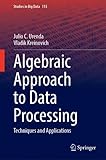Algebraic Approach to Data Processing [electronic resource] : Techniques and Applications /
Material type: TextSeries: Studies in Big Data ; 115Publisher: Cham : Springer International Publishing : Imprint: Springer, 2022Edition: 1st ed. 2022Description: XIII, 250 p. 8 illus., 4 illus. in color. online resourceContent type:
TextSeries: Studies in Big Data ; 115Publisher: Cham : Springer International Publishing : Imprint: Springer, 2022Edition: 1st ed. 2022Description: XIII, 250 p. 8 illus., 4 illus. in color. online resourceContent type: - text
- computer
- online resource
- 9783031167805
- 620.00285 23
- TA345-345.5
Introduction -- What Are the Most Natural and the Most Frequent Transformations -- Which Functions and Which Families of Functions Are Invariant -- What Is the General Relation Between Invariance And Optimality -- General Application: Dynamical Systems -- First Application to Physics: Why Liquids? -- Second Application to Physics: Warping of Our Galaxy.
The book explores a new general approach to selecting—and designing—data processing techniques. Symmetry and invariance ideas behind this algebraic approach have been successful in physics, where many new theories are formulated in symmetry terms. The book explains this approach and expands it to new application areas ranging from engineering, medicine, education to social sciences. In many cases, this approach leads to optimal techniques and optimal solutions. That the same data processing techniques help us better analyze wooden structures, lung dysfunctions, and deep learning algorithms is a good indication that these techniques can be used in many other applications as well. The book is recommended to researchers and practitioners who need to select a data processing technique—or who want to design a new technique when the existing techniques do not work. It is also recommended to students who want to learn the state-of-the-art data processing. .


There are no comments on this title.